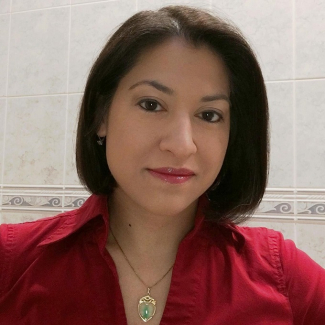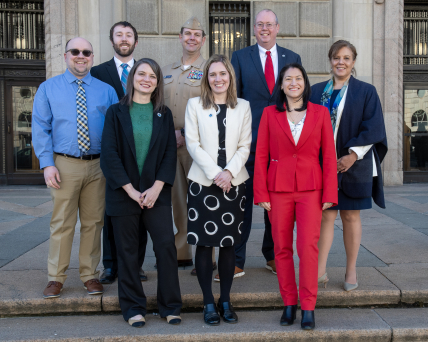
Kim McMahon
National Weather Service
Location: Silver Spring, MD
Office: NWS Headquarters / Analyze, Forecast, and Support Office / Public Weather Services Program
Job Title: Public Weather Services Program Manager
Educational Background:
- I received my Bachelor’s degree in Atmospheric Science with a double minor in Broadcast Meteorology and Mathematics from the University at Albany (UAlbany). I worked several years as a forecaster before deciding to pursue a Master’s degree in Executive Leadership. I was able to work rotating shifts while obtaining my Master’s in 2017.
Describe the career path that led you to your current job with the National Weather Service.
-
My first introduction to the NWS was the summer after my freshman year of college when I volunteered at WFO Upton, NY, through a connection with my high school environmental science teacher. I shadowed forecasters, learned how to launch weather balloons, and helped analyze historic tornadic data.
Returning to UAlbany in my sophomore year, I began working for the university’s Atmospheric Science Research Center (ASRC), then became a student volunteer at WFO Albany, NY, as part of an internship program. After volunteering, I applied for the Student Temporary Employment Program (STEP) at WFO Albany. During my senior year, I was working as a STEP at the WFO, a research assistant at ASRC, and an unpaid internship at the local Fox affiliate under their chief broadcast meteorologist.
Having the opportunity to work in research, operational, and broadcast meteorology as a student helped me determine which path I wanted to take as a career. Nearing graduation from my undergraduate degree, I applied to about 8 or so NWS entry-level permanent employment positions at WFOs across the country, back then known as “meteorological intern.” I was also applying outside NWS just in hopes of having a job lined up after graduation in operational meteorology. I accepted a forecasting position at Dugway Proving Ground under the Department of the Army, about an hour and a half outside of Salt Lake City, UT. It was an incredible experience to live in a very different part of the country from my NY roots and to see how different the weather could be in a very different climate, elevation, and landscape.
I knew I wanted to rejoin the NWS, so after working at Dugway for approximately 2 years, I was able to return to WFO Albany, NY as a lateral transfer. I spent about 5 years at WFO Albany, in which time I got married, resulting in greater considerations for where I could apply to become a General Forecaster. In 2012, I found my position at WFO Burlington, VT (BTV). At BTV, I was able to hold several focal point positions, lead the office transition to digital aviation services, and establish the office’s first leadership team aimed at enhancing staff leadership, team building, and collaboration skills. These opportunities and the MIC informing me of other career paths in the NWS led me to my next position.
In 2017, I transitioned from forecasting to focus on programmatic policy as the NWS Eastern Region Tropical, Marine, and Tsunami Program Manager overseeing Weather Forecast Offices stretching from Maine to Ohio to South Carolina. This position allowed me to have a broader perspective of NWS, allowed me to work one on one with a large variety of WFOs, and collaborate with other regions and NWS Headquarters. During this time, I also discovered how this type of position aligned with my core values and strengths, such as organization and effective communication. In my time at ERH, I saw that I was able to improve communication, training, and engagement. While I felt like I could continue to make a difference in that role, when the announcement for the Public Weather Services Program Manager position at NWS headquarters was open, I applied, hoping to make a positive impact at a larger scale.
I accepted my current role as National Public Weather Services Program Manager in 2020.
What do you do for the NWS?
- As the Public Weather Services Program Manager for NWS, I oversee the policies, procedures, and guidelines of 122 local NWS Forecast Offices on routine weather forecast products and hazards ranging from extreme temperatures, non-tropical wind, frost/freeze, dust storms/blowing dust, dense fog, freezing fog, dense smoke, volcanic ashfall, and air quality. I am also one of the coleads for the National Integrated Heat-Health Information System (NIHHIS), founded by NOAA and CDC, to coordinate and collaborate on research, initiatives, and messaging regarding heat and heat health across federal agencies.
This means that I work with regional program managers and the Weather Prediction Center to improve products and services, including tools for WFOs and partners. I also work across federal agencies in my role with NIHHIS to align federal efforts on heat.
What was the most interesting, exciting, or impactful weather/water event you experienced while working for the NWS and why does it stand out?
- While working at WFO Albany, I worked several shifts during Hurricane Irene, which had weakened to a tropical storm. While the wind was not as much of a factor by the time it moved into our area of responsibility, the whole event was unprecedented. WFO Albany rarely issued Hurricane or Tropical Storm Warnings and until that point, had only done so for the most southern tier of its counties. The amount of rain, inland and river flooding, and resulting impacts were difficult to process mentally and emotionally. Even after the flooding had receded and I was able to join other staff members to areas that had experienced damaging flooding, noting how high the water reached on buildings or valley slopes, I still was in awe and disbelief.
What made you decide to pursue a career with the NWS?
- Before applying to college, I knew I wanted to study meteorology. I kept in touch with my high school environmental science teacher, and after my first year of undergrad, he saw how enthusiastic I was to learn more about possible career paths in meteorology. He put me in touch with the Science Operations Officer in WFO Upton, NY, and I was able to volunteer there the summer after my freshman year. I was able to gain more experience with NWS throughout my undergraduate studies and saw the direct connection between the work being done by the staff and the impact to people around us in our community and County Warning Area. I also was able to participate in outreach events and connect people with our information and how it can prepare them for hazardous weather.
What do you like most about working for the NWS?
- The passion and dedication of the NWS workforce is inspiring. I think part of this stems from the NWS’s mission of protection of life and property and enhancement of the national economy. Meteorologists, hydrologists, electronics technicians, administrative assistants, and more all see that weather affects everyone, and the NWS can have a big impact on preparing communities for hazardous weather events. The ability to see how the work we do makes a difference just drives our workforce to strive to do even better. That is clearly seen in NWS’s evolution from being purely weather forecasting and dissemination of information to a more holistic service of Impact-based Decision Support, messaging and communication, incorporating more probabilistic information and Social Behavioral Economic Sciences.
What advice do you have for someone interested in a career with the NWS?
-
The NWS has offices across the country. Find one to tour, volunteer, and shadow a forecaster. While there, ask everyone what they did to find their way into the NWS. Everyone I’ve come across has a different story and there’s no one correct path.
I would also recommend looking for opportunities and asking others you know in the sciences for connections or opportunities. You can take advantage of social media too, as many of our local weather forecast offices post learning sessions, internship opportunities, and more!
Don’t hesitate to apply for an opportunity because if you don’t try, you’ll never know. It may be difficult, but if it’s what you want to do, don’t let others dissuade you, even if it means blazing your own path.
What training or coursework would you recommend to someone interested in following your career path?
-
In a nutshell, I’d say “Never stop learning!” There are so many aspects to becoming a more effective NWS staff member who can contribute, so don’t lose sight of seeking more knowledge and trying new opportunities.
In-depth leadership development is something I recommend to everyone. It will help you attain greater self-awareness and understand your core values and principles, which will in turn help you understand your strengths and how to apply them. Leadership training will also help you understand others, which is vital for all the collaborative work a program manager at regional or national headquarters needs. Remember that nothing can be accomplished without the help of others.
Another recommendation I have is to take the time to try different focal point duties, and volunteer to lead teams and projects. This will help you build and practice those leadership skills, in addition to organization and communications skills. Also, if you create something to help yourself on a project, for example, a tracking spreadsheet, don’t be afraid to share that with others as it may help them too. By sharing, you will likely get input to improve it in ways you may not have thought of.
For more specific topics to look into: take media training as it will not only help you during media interviews and job interviews, but also how to present your thoughts more effectively and succinctly. Take this kind of training periodically to keep those skills fresh. Also, work on your writing skills because program management includes lots of written communication from drafting NWS directives to Product Description Documents to meeting minutes to compiling best practices for NWS staff. There are formal program and project management courses and certifications which will help to find effective ways to manage projects.
Anything else you want to share?
- I have had the privilege of having many caring and generous informal mentors throughout my career. These informal mentors have helped me navigate the ins and outs of daily career life as well as influence career decisions such as pursuing a master’s degree, which projects and focal point duties I took on, and what career opportunities existed that I may not have known or thought about. My successes have rarely been just mine. They are shared with the people who have guided me, collaborated with me, and given me opportunities to channel my focus and passion. I am eternally grateful.



